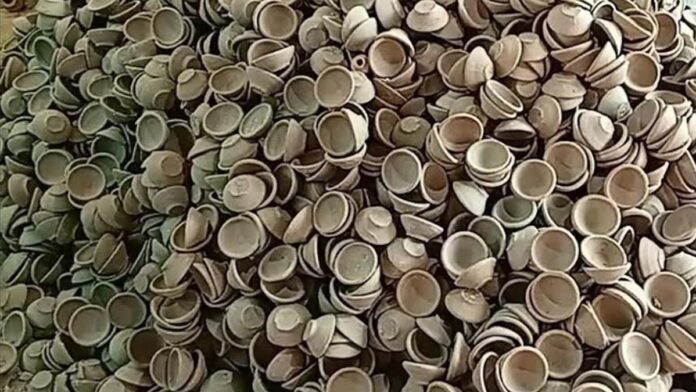Jaipur: This Diwali, markets in Jaipur have witnessed a remarkable surge in demand for clay lamps (mitti ke diye) and Indian decorative items. Unlike previous years, when Chinese lights and decorations dominated Diwali shopping, this time customers are prioritizing traditional Indian products such as earthen lamps, kalash, and handcrafted decor. The impact of Prime Minister Narendra Modi’s ‘Vocal for Local’ campaign is clearly visible in Jaipur’s markets.
Employment for the Prajapati Community
Rakesh Kumhar, who has been making clay lamps for years, shared that during the Diwali season, he produces around 2 to 2.5 lakh lamps. He currently makes about 4,000 to 5,000 lamps per day, with his entire family involved in the work. Due to high demand this year, his production has increased significantly — up from about 1 lakh lamps in previous years to around 2.5 lakh now. He believes all the lamps will be sold by Diwali day. In recent years, Chinese lamps had significantly reduced his sales, but this year, people are once again turning to traditional clay lamps.
How Clay Lamps Are Made
Rakesh explains that making clay lamps and other items takes considerable effort. The increase in demand this year is finally giving artisans fair compensation for their hard work.
The process begins with selecting fine clay, typically from river or pond banks. The clay is sieved to remove pebbles, roots, and other impurities. It is then kneaded with water to become soft, smooth, and flexible. The prepared clay is left covered overnight to enhance its texture.
Next, the clay is shaped on a potter’s wheel (charkha) to make lamps, pots, incense holders, and utensils. These items are then sun-dried and decorated, ready for sale.
Soaring Demand for Clay Lamps
Vimla Devi, a customer, said,
“A clay lamp isn’t just a source of light — it reflects the dignity of Indian culture and emotion. In our traditions, clay is sacred and used in weddings and auspicious rituals.”
While Chinese products might be cheaper, they lack the emotional and cultural depth of traditional items. Clay lamps are eco-friendly and biodegradable, causing no harm to nature after use. This year, common citizens, traders, social workers, women, and community organizations are actively supporting local pottery and earthenware by choosing these products over imported ones.
Special Designs on Clay Lamps and Pots
To make them more attractive, colorful patterns are painted on the lamps, kalash, and other clay items. Artisans use a special cone (similar to a piping bag) filled with colored paint to carefully draw intricate designs, making each piece unique and visually appealing.
A Shift Back to Indigenous Products
Suresh Kumhar, a lamp vendor, stated that sales of clay lamps have increased significantly this year:
“People are now returning to indigenous goods, which is giving us a good income.”
Festivity Returns to Potter Families
Artisans begin preparing for Diwali at least a month in advance. Their entire families contribute — some mold the lamps, while others assist with coloring and decorating.
“This year, demand is so high that the wholesale price has gone up from ₹600 to ₹750 per 1,000 lamps,” said a potter happily.





